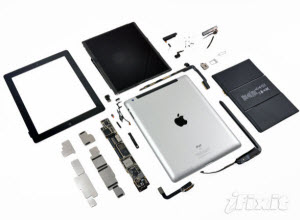Who cares that the iPad 3 is thicker and heavier than the iPad 2?

The new iPad -- aka the iPad 3 -- is 0.03-inch (0.6 mm) thicker and 0.12 pounds (49 grams) heavier than the iPad 2. Apart from those small number of people who obsess over technical specifications, does anyone really care about these increases?

"The plan was to use this new technology called IGZO from Sharp -- a lot higher electron mobility that allows them to make the transistors a lot smaller and the circuit elements a lot smaller," he said.
IGZO -- short for Indium Gallium Zinc Oxide -- technology would have meant smaller transistors in the panel, which would have reduced on the number of backlights needed to the screen. This, in turn, would have resulted in a thinner display and reduced battery consumption.
However, according to Soneira, Sharp didn't have the IGZO display technology ready in time for the iPad 3. This meant that Apple had to use more conventional amorphous silicon technology.
"There's no question that the iPad 3 is Plan B. They pushed amorphous silicon to a higher [pixels per inch density] than anybody else. But the light throughput is not good. So it has roughly twice as many LEDs, and they had to get a 70 percent larger battery," Soneira said, referring to the third-generation iPad.
But the question is, does it matter that Apple didn't use IGZO display technology? Or, to put that question the other way, does it matter that the iPad 3 is thicker and heavier than the iPad 2?
From a technical standpoint, I understand Soneira's argument, but from an end-product or user standpoint, I think that it's overblown for several reasons.
First, the size and weight gain of the iPad 3 compared to earlier models is negligible. If the back of the new iPad wasn't beveled differently to the iPad 2, there's no way that I could tell the difference between the two devices by feel alone. I tested this out on several other people the other day, and none of them could tell the difference between the two models based on weight and thickness alone. It seems that we're just not calibrated to pick up on changes that small, and I think that Apple knew this when it designed the iPad 3.
Not only are the changes so small that we humans don't notice them, they're so small as to be mechanically irrelevant. We know this because most cases designed to fit the iPad 2 will comfortably fit the iPad 3.
By using older amorphous silicon screen technology as opposed to IGZO, Apple had to fit more backlights into the iPad's screen, along with a battery that had 70 percent more capacity than the battery powering the iPad 2. But since it managed to do this with only negligible gains in size and weight, and managed to keep the battery life the same as for the iPad 2, what display technology the iPad 3 used is irrelevant as far as consumers are concerned.
Most people are looking at what's on the screen, not what went into the making of it.
Another point worth raising here relates to how companies develop products. Phrases like "Plan B" tend to give the impression that Apple made a last-minute switch from planning to use IGZO technology to instead using older amorphous silicon screen technology.
Product development doesn't work like that.
While there would have been advantages in Apple using IGZO technology, the decision as to whether the technology was ready -- in terms of reliability, yield, cost and so on -- would have been made months before the first iPad rolled off the production line. There would have been nothing last minute about the decision. Also, we have nothing but rumors to go on to suggest that Apple had ever planned to use IGZO for the iPad 3.
Bottom line, Apple made the best iPad possible given the size, weight and cost limitations.
If your reason for not wanting an iPad is the fact that it's 0.03-inch thicker and 0.12 pounds heavier, then you really need to find a hobby.
Image source: iFixit.
Related:
Best tablet for those who don't want an iPad
| Image Gallery: Best tablet for those who don't want an iPad | ||||||
- iPhone touch panel shipments to fall 15-20 percent in Q2 2012
- Best earphones for your iPhone and iPad
- Jailbroken iPads can now multitask apps
- Top accessories for your iPhone and iPad
- 100 reasons to jailbreak an iPhone
- The iPad's missing feature: multitasking
- Oops! New iPad drop test
- New iPad accounts for 6 percent of iPad traffic
- Why Apple doesn't need to innovate much to stay ahead of the competition
- New iPad's most revolutionary feature is its battery
- Why Apple's iPad rebranding makes sense